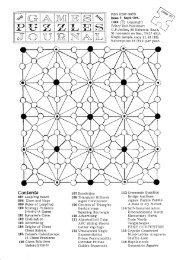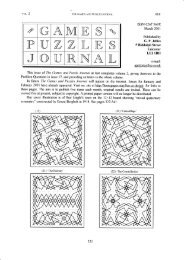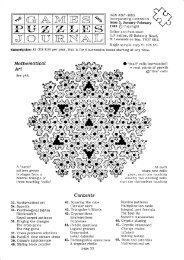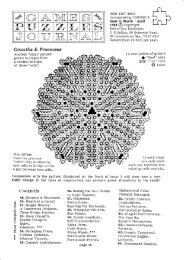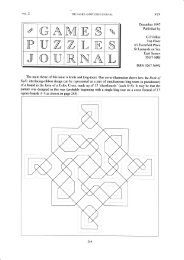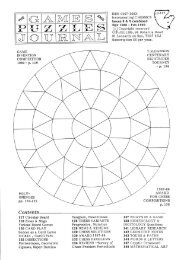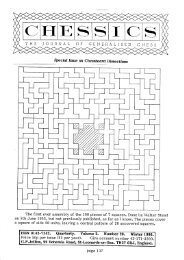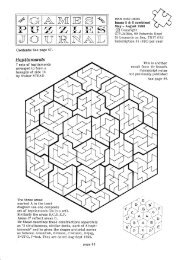The Games and Puzzles Journal, #12 - Mayhematics
The Games and Puzzles Journal, #12 - Mayhematics
The Games and Puzzles Journal, #12 - Mayhematics
You also want an ePaper? Increase the reach of your titles
YUMPU automatically turns print PDFs into web optimized ePapers that Google loves.
page 1' 92<br />
THE<br />
GAMES AND PUZZLES JOURNAL<br />
Mathematics in Music - <strong>The</strong> Reversed Keyboard <strong>and</strong> a Revised Stave Notation<br />
by Graham LIPSCOMB<br />
My synthesizer can be programmed to play any note on any key, which led me to setting it up<br />
so that all the notes were bactcwards or "mirror-image". Obviously if you look at a keyboard<br />
inamimornDrr<strong>and</strong>"Aflat"areinterchanged,C=E,F=BrG=Aretc.Playingthereversed<br />
keyboard while st<strong>and</strong>ing behind the synthesizer is not too difficutt since the notes are effectivety<br />
as normal, but playing from the front leads to some interesting realizations.<br />
Now of course b fvfaj6r scale is symmetrical about D (our mirror note) since all the white<br />
notes in the mirror still equal all the white notes. But what about G major scale (F sharp instead<br />
of F). F sharp is B flat in ine mirror so now we've got F maJor in the mirror as a reflection of<br />
G major. so ine key with one sharp becomes the key.with one flat. Similarly with two sharps<br />
(D), t"hree sharps (n), etc. becoming two flats (B flat), three flats (E flat) <strong>and</strong> so on.<br />
Furthermor",,ih" forming of -chords is quite interesting: All major triads become minor<br />
triads (<strong>and</strong> vice versa). Dominant sevenths become minor sevenths with flattened fifth' Major<br />
sevenths become other major sevenths. Minor sevenths also become other minor sevenths'<br />
Nintn, become other ninthi. Diminished <strong>and</strong> Augmented chords are mathematical chords anyway<br />
as they consist of repeated minor thirds orhajor thirds respectively up <strong>and</strong> down the keyboard.<br />
This pattern is obviously unchanged in the mirror'<br />
In all of these cases the new chorc will be rooted on a different note depending on the<br />
type of chord: c major = A minor, c minor = A malor, C7 = F sharp minor ? flats, c major ?th<br />
=Fma'or?th,Cminor?th=Fstrarpminor?th,C0=Dg,Cmajorgth=Dminorgth,Cminor<br />
gth = D major gth, C diminished = A diminished, C augmented = A flat augmented.<br />
All of this is fairly easy to see on the piano, but very hidden on the staves because musical<br />
notation on staves onty"attows for seven notes <strong>and</strong> not all twelve. <strong>The</strong> reason of course is that a<br />
key can only contain s-even notes naturally, the use of accidentals in a piece is effectively a<br />
cninge of kly (i.e. a new set of seven notes). Using lines <strong>and</strong> spaces enables many notes to be<br />
crammed into a small sPace.<br />
However, it is annoying that the two staves have notes in slightly different positions. Also'<br />
having to deal with up to ni@ leger lines is difficult. My thoughts o_n a better system are as<br />
tottor,is: (a) Two fege'r lines betlieen staves instead of one. (bITrebte stave pattern (E'-9' B' D' F)<br />
is then repeated foi uass stave (the two leger lines are A <strong>and</strong> c). (c) <strong>The</strong>re are enough lines above<br />
the treble stave for an additional stave *it ing top c conveniently sit two leger lines above it.<br />
If another stave were added below the bass end <strong>and</strong> two leger lines below it you would have a very<br />
n""t rungu of four staves <strong>and</strong> five pairs of legers, giving 8* octaves A - C. Unfortunately gr<strong>and</strong><br />
piano range is only ?i octaves A - C!<br />
+<br />
fopC<br />
Mid c<br />
Footnote by G. P. JELLISS:<br />
Years ago, when I was an unsuccessful<br />
clarinet player, I devised a simplified<br />
scheme of notation for chromatic $Znote<br />
scale) music, doing away with the<br />
sharps <strong>and</strong> flats. Instead of the usual<br />
key signatures, a number is placed on<br />
the centre stave, 8 indicating a frequency<br />
of 2 to the power 8 = 256 cyles<br />
per second, which, if I remember right,<br />
is the frequency of middle C (or near<br />
enough to it). Thus I signifies 2 to the<br />
gth = 5L2, i.e. the octave above. Notes<br />
on <strong>and</strong> between the lines, including one<br />
intermediate leger line, give the L2.




